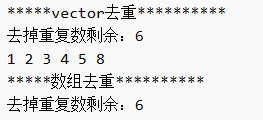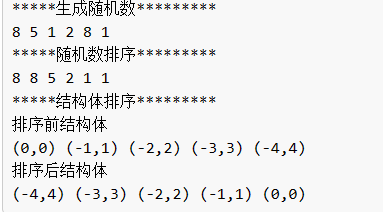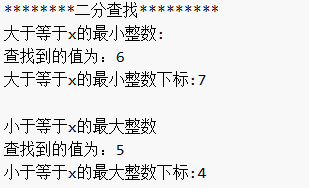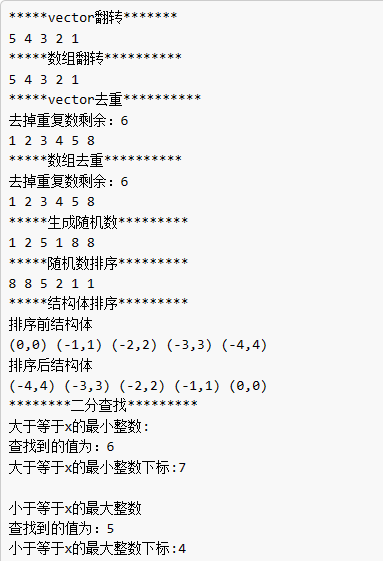C++ STL容器与常用库函数
STL是提高C++编写效率的一个利器
STL容器:
一、#include <vector>
英文翻译:vector :向量
vector是变长数组(动态变化),支持随机访问,不支持在任意位置O(1)插入。为了保证效率,元素的增删一般应该在末尾进行。
声明
#include<vector> 头文件
vector<int>a; 相当于一个长度动态变化的int数组
vector<int>b[233]; 相当于第一维长233,第二位长度动态变化的int数组
struct rec{…};
vector<rec>c; 自定义的结构体类型也可以保存在vector中
size/empty
size函数返回vector的实际长度(包含的元素个数),empty函数返回一个bool类型,表明vector是否为空。二者的时间复杂度都是O(1)。
所有的STL容器都支持这两个方法,含义也相同。
clear
clear函数把vector清空。
front/back
front函数返回vector的第一个元素,等价于*a.begin() 和 a[0]。
back函数返回vector的最后一个元素,等价于*==a.end() 和 a[a.size() – 1]。
push_back() 和pop_back()
a.push_back(x) 把元素x插入到vector a的尾部。
b.pop_back()删除vector a的最后一个元素。
#include<iostream>
#include<vector>
using namespace std;
int main()
{
vector<int> a; //相当于一个长度动态变化的int数组
vector<int> b[233]; //相当于第一维长233,第二位长度动态变化的int数组
a.size(); //函数返回vector的实际长度(包含的元素个数)
a.empty(); //函数返回一个bool类型,表明vector是否为空。
a.clear(); //clear函数把vector清空
struct rec{
int a;
double b;
};
vector<rec> c; //自定义的结构体类型也可以保存在vector中
vector<int> d({1,2,3});
cout<<d.front()<<" "<<d[0]<<" "<<endl;
cout<<d.back()<<" "<<d[d.size()-1]<<" "<<endl;
d.push_back(4);
for(auto x:d)cout<<x<<" ";//把元素x插入到vector a的尾部。
cout<<endl;
d.pop_back();
for(auto x:d)cout<<x<<" ";//删除vector a的最后一个元素。
cout<<endl;
return 0;
}二、#include <queue>
英文翻译:queue :队列
头文件queue主要包括循环队列(先进先出)
queue和优先队列priority_queue两个容器。
声明
queue<int>q;//队列
structrec{…}; queue<rec> q; //结构体rec中必须定义小于号
priority_queue<int>q; // 大根堆
priority_queue<int,vector<int>, greater<int> q; //小根堆
priority_queue<pair<int,int>>q; //小根堆
循环队列 queue
push从队尾插入
pop从队头弹出
front返回队头元素
back返回队尾元素
优先队列 priority_queue(堆)
**默认为大根堆
push把元素插入堆
pop删除堆顶元素
top 查询堆顶元素(最大值)
#include<iostream>
#include<queue>
using namespace std;
int main()
{
queue<int> q;//队列
queue<double> q1;
struct rec{
int a,b;
bool operator< (const rec& t)const
{
return a<t.a;
}
}; queue<rec> q2; //结构体rec中必须定义小于号
priority_queue<int> q3; // 大根堆
priority_queue<int, vector<int>, greater<int>>q4; // 小根堆
priority_queue<pair<int, int>>q5;
queue<int> s;//队列
s.push(1); //从队尾插入
s.pop(); //从队头弹出
s.front(); //返回队头元素
s.back(); //返回队尾元素
priority_queue<int> s1;
s1.push(1); //把元素插入堆
s1.pop(); //删除堆顶元素
s1.top(); //查询堆顶元素(最大值)
? ? s1.push(-x); //按小根堆插入
return 0;
}三、#include <stack>
英文翻译:stack :堆栈
头文件stack包含栈。声明和前面的容器类似。
push 向栈顶插入
pop 弹出栈顶元素
#include<iostream>
#include<stack>
using namespace std;
int main()
{
stack<int>stk;
stk.push(1);//向栈顶插入元素
stk.pop(); //弹出栈顶元素
stk.top(); //查询栈顶元素(最大值)
return 0;
}四、#include <deque>
双端队列deque是一个支持在两端高效插入或删除元素的连续线性存储空间。它就像是vector和queue的结合。与vector相比,deque在头部增删元素仅需要O(1)的时间;与queue相比,deque像数组一样支持随机访问。
[] 随机访问
front/back 队头/队尾元素
push_back 从队尾入队
push_front 从队头入队
pop_back 从队尾出队
pop_front 从队头出队
clear 清空队列
#include<iostream>
#include<deque>
using namespace std;
int main()
{
deque<int>a;
a[0]; //随机访问
a.front(); a.back();//队头/队尾元素
a.push_back(1); //从队尾入队
a.push_front(2); //从队头入队
a.pop_back(); //从队尾出队
a.pop_front(); //从队头出队
a.clear(); //清空队列
return 0;
}五、#include <set>
英文翻译: set :集
头文件set主要包括set和multiset两个容器,分别是“有序集合”和“有序多重集合”,即前者的元素不能重复,而后者可以包含若干个相等的元素。set和multiset的内部实现是一棵红黑树,它们支持的函数基本相同。
声明
set<int> s;
struct rec{…}; set<rec> s; //结构体rec中必须定义小于号
multiset<double> s;
size/empty/clear
与vector类似
insert
s.insert(x)把一个元素x插入到集合s中,时间复杂度为O(logn)。
在set中,若元素已存在,则不会重复插入该元素,对集合的状态无影响。
find
s.find(x) 在集合s中查找等于x的元素,并返回指向该元素的迭代器。
若不存在,则返回s.end()。时间复杂度为O(logn)。
lower_bound/upper_bound
这两个函数的用法与find类似,但查找的条件略有不同,时间复杂度为 O(logn)。
s.lower_bound(x) 查找大于等于x的元素中最小的一个,并返回指向该元素的迭代器。
s.upper_bound(x) 查找大于x的元素中最小的一个,并返回指向该元素的迭代器。
count
s.count(x)返回集合s中等于x的元素个数,时间复杂度为 O(k +logn),其中k为元素x的个数。
#include<iostream>
#include<set>
using namespace std;
int main()
{
set<int>a;//元素不能重复
multiset<int>b;//元素可以重复
int x;
a.insert(x);//把一个元素x插入到集合x中
if(a.find(x)==a.end())//判断x是否存在于x中
a.lower_bound(x);//查找大于等于x的元素中最小的一个
a.upper_bound(x);//查找大于x的元素中最小的一个
b.count(x);//返回集合b中等于x的元素个数
return 0;
}六、#include <map>
#include<unordered_map>
英文翻译: map:地图
map容器是一个键值对key-value的映射,其内部实现是一棵以key为关键码的红黑树。Map的key和value可以是任意类型,其中key必须定义小于号运算符。
声明
map<key_type,value_type> name;
例如:
map<long,long, bool> vis;
map<string,int> hash;
map<pair<int,int>, vector<int>> test;
size/empty/clear/begin/end
均与set类似。
Insert/erase
与set类似,但其参数均是pair<key_type, value_type>。
find
h.find(x)在变量名为h的map中查找key为x的二元组。
[]操作符
h[key]返回key映射的value的引用,时间复杂度为O(logn)。
[]操作符是map最吸引人的地方。我们可以很方便地通过h[key]来得到key对应的value,还可以对h[key]进行赋值操作,改变key对应的value。
#include<iostream>
#include<map>
#include<vector>
using namespace std;
int main()
{
//相当于数组
map<int,int>a;
a[10000]=8;
cout<<a[10000]<<endl;
//和数组的区别(可以随便定义数组类型,包括下标)
map<string,int>b;
b["zyq"]=9;
cout<<b["zyq"]<<endl;
map<string,vector<int>>c;
c["zyq"]=vector<int>({1,2,3,4,5,6});
cout<<c["zyq"][2]<<endl;
c.insert({"b",{10}});
cout<<(c.find("b")==c.end())<<endl;//输出0为存在,输出1为不存在
return 0;
}map和unordered_map的区别
一.头文件不同,分别是:
#include<map>
#include<unordered_map>
二.其实现不同
map:其实现是使用了红黑树
unordered_map:其实现使用的是哈希表
三.特点
map:
1.元素有序,并且具有自动排序的功能(因为红黑树具有自动排序的功能)
2.元素按照二叉搜索树存储的,也就是说,其左子树上所有节点的键值都小于根节点的键值,右子树所有节点的键值都大于根节点的键值,使用中序遍历可将键值按照从小到大遍历出来
3.空间占用率高,因为map内部实现了红黑树,虽然提高了运行效率,但是因为每一个节点都需要额外保存父节点、孩子节点和红/黑性质,使得每一个节点都占用大量的空间
4.适用情况:对顺序有要求的情况下,如排序等
unordered_map:
-
元素无序。
-
查找速度非常的快。
-
哈希表的建立比较耗费时间
-
适用情况:对于查找问题
-
对于unordered_map或者unordered_set容器,其遍历顺序与创建该容器时输入元素的顺序是不一定一致的,遍历是按照哈希表从前往后依次遍历的
七、#include<string>
1.size/empty/clear/begin/end
string均可以用
2.substr();
返回字符串长度
#include<bits/stdc++.h>
using namespace std;
int main()
{
string a="abnd";
a+="hdush";//a="abndhdush"
a+='z';//a="abndhdushz"
//从第1个(起始点在0)位置开始,输出3个字符
cout<<a.substr(1,3);//bnd
cout<<endl;
//输出从4开始的整个子串
cout<<a.substr(4);//hdushz
return 0;
}八、位运算
& 与
| 或
~ 非
^ 异或
>> 右移
<< 左移
常用操作:
-
求x的第k位数字 x >> k & 1
-
lowbit(x) = x & -x,返回x的最后一位1
九、总结:
vector, 变长数组,倍增的思想
size() 返回元素个数
empty() 返回是否为空
clear() 清空
front()/back()
push_back()/pop_back()
begin()/end()
[]
支持比较运算,按字典序
pair<int, int>
first, 第一个元素
second, 第二个元素
支持比较运算,以first为第一关键字,以second为第二关键字(字典序)
string,字符串
size()/length() 返回字符串长度
empty()
clear()
substr(起始下标,(子串长度)) 返回子串
c_str() 返回字符串所在字符数组的起始地址
queue, 队列
size()
empty()
push() 向队尾插入一个元素
front() 返回队头元素
back() 返回队尾元素
pop() 弹出队头元素
priority_queue, 优先队列,默认是大根堆
size()
empty()
push() 插入一个元素
top() 返回堆顶元素
pop() 弹出堆顶元素
定义成小根堆的方式:priority_queue<int, vector<int>, greater<int>> q;
? ? 也可以使用push(-x) 变成一个小根堆
stack, 栈
size()
empty()
push() 向栈顶插入一个元素
top() 返回栈顶元素
pop() 弹出栈顶元素
deque, 双端队列
size()
empty()
clear()
front()/back()
push_back()/pop_back()
push_front()/pop_front()
begin()/end()
[]
set, map, multiset, multimap, 基于平衡二叉树(红黑树),动态维护有序序列
size()
empty()
clear()
begin()/end()
++, -- 返回前驱和后继,时间复杂度 O(logn)
set/multiset
insert() 插入一个数
find() 查找一个数
count() 返回某一个数的个数
erase()
(1) 输入是一个数x,删除所有x O(k + logn)
(2) 输入一个迭代器,删除这个迭代器
lower_bound()/upper_bound()
lower_bound(x) 返回大于等于x的最小的数的迭代器
upper_bound(x) 返回大于x的最小的数的迭代器
map/multimap
insert() 插入的数是一个pair
erase() 输入的参数是pair或者迭代器
find()
[] 注意multimap不支持此操作。 时间复杂度是 O(logn)
lower_bound()/upper_bound()
unordered_set, unordered_map, unordered_multiset, unordered_multimap, 哈希表
和上面类似,增删改查的时间复杂度是 O(1)
不支持 lower_bound()/upper_bound(), 迭代器的++,--
bitset, 圧位
bitset<10000> s;
~, &, |, ^
>>, <<
==, !=
[]
count() 返回有多少个1
any() 判断是否至少有一个1
none() 判断是否全为0
set() 把所有位置成1
set(k, v) 将第k位变成v
reset() 把所有位变成0
flip() 等价于~
flip(k) 把第k位取反
常用库函数
C++帮我们实现好了很多有用的函数,我们要避免重复造轮子
#include<algorithm>算法库
reverse 翻转(十星重要度)
翻转一个vector:
reverse(a.begin(), a.end());
翻转一个数组,元素存放在下标1~n:
reverse(a + 1, a + 1 + n);
cout<<"*****vector翻转*******"<<endl;
vector<int> a({1,2,3,4,5});
reverse(a.begin(),a.end());
for(int x:a)cout<<x<<" ";
cout<<endl;
cout<<"*****数组翻转**********"<<endl;
int b[]={1,2,3,4,5};
reverse(b,b+5);
for(int y:b)cout<<y<<" ";
cout<<endl;
unique 去重
返回去重之后的尾迭代器(或指针),仍然为前闭后开,即这个迭代器是去重之后末尾元素的下一个位置。该函数常用于离散化,利用迭代器(或指针)的减法,可计算出去重后的元素个数。
把一个vector去重:
int m = unique(a.begin(), a.end()) – a.begin();
把一个数组去重,元素存放在下标1~n:
int m = unique(a + 1, a + 1 + n) – (a + 1);
cout<<"*****vector去重**********"<<endl;
vector<int> a1({1,1,2,2,3,3,4,5,8,8,8,8,8,8});
int n=unique(a1.begin(),a1.end())-a1.begin();
cout<<"去掉重复数剩余:"<<n<<endl;
for(int i=0;i<n;i++)cout<<a1[i]<<" ";
cout<<endl;
cout<<"*****数组去重**********"<<endl;
int b1[]={1,1,2,2,3,3,4,5,8,8,8,8,8,8};
int m=unique(b1,b1+14)-b1;
cout<<"去掉重复数剩余:"<<m<<endl;
for(int i=0;i<m;i++)cout<<b1[i]<<" ";
cout<<endl;
random_shuffle 随机打乱
用法与reverse相同
cout<<"*****生成随机数*********"<<endl;
vector<int> c({1,1,2,8,5,8});
srand((time(0)));//需要生成随机数
random_shuffle(c.begin(),c.end());
for(int q:c)cout<<q<<" ";
cout<<endl;
sort(十星重要度)
对两个迭代器(或指针)指定的部分进行快速排序。可以在第三个参数传入定义大小比较的函数,或者重载“小于号”运算符。
把一个int数组(元素存放在下标1~n)从大到小排序,传入比较函数:
int a[MAX_SIZE];
bool cmp(int a, int b) {return a > b; }
sort(a + 1, a + 1 + n, cmp);
把自定义的结构体vector排序,重载“小于号”运算符:
方法一:
struct rec{ int id, x, y; }
vector<rec> a;
bool operator <(const rec &a, const rec &b) {
return a.x < b.x ||a.x == b.x && a.y < b.y;
}
sort(a.begin(), a.end());
方法二:(推荐)
struct rep
{
int x,y;
}r[5];
//结构体的比较函数
bool cmp1(rep a,rep b) //自己决定如何排序
{
return a.x<a.y;//这里决定sort排序是升序还是降序
}
//定义的结构体
struct rep
{
int x,y;
}r[5];
//结构体的比较函数
bool cmp1(rep a,rep b) //自己决定如何排序
{
return a.x<a.y;//这里决定sort排序是升序还是降序
}
//数组的比较函数
bool cmp(int a,int b) //自己决定如何排序
{
return a>b;//这里决定sort排序是升序还是降序
}
cout<<"*****随机数排序*********"<<endl;
sort(c.begin(),c.end(),cmp);
for(int q1:c)cout<<q1<<" ";
cout<<endl;
cout<<"*****结构体排序*********"<<endl;
for(int i=0;i<5;i++)
{
r[i].x=-i;
r[i].y=i;
}
cout<<"排序前结构体"<<endl;
for(int i=0;i<5;i++)printf("(%d,%d) ",r[i].x,r[i].y);
cout<<endl;
sort(r,r+5,cmp1);
cout<<"排序后结构体"<<endl;
for(int i=0;i<5;i++)printf("(%d,%d) ",r[i].x,r[i].y);
lower_bound/upper_bound 二分
lower_bound 的第三个参数传入一个元素x,在两个迭代器(指针)指定的部分上执行二分查找,返回指向第一个大于等于x的元素的位置的迭代器(指针)。
upper_bound 的用法和lower_bound大致相同,唯一的区别是查找第一个大于x的元素。当然,两个迭代器(指针)指定的部分应该是提前排好序的。
在有序int数组(元素存放在下标1~n)中查找大于等于x的最小整数的下标:
int I = lower_bound(a + 1, a + 1 + n,. x) – a;
在有序vector<int> 中查找小于等于x的最大整数(假设一定存在):
int y = *--upper_bound(a.begin(), a.end(), x);
cout<<"********二分查找*********"<<endl;
cout<<"大于等于x的最小整数:"<<endl;
int x[]={1,2,3,4,5,6,9,10};
int* p=lower_bound(x,x+7,6);
cout<<"查找到的值为:"<<*p<<endl;
int l=*p=lower_bound(x,x+7,10)-x;
cout<<"大于等于x的最小整数下标:"<<l<<endl<<endl;
cout<<"小于等于x的最大整数"<<endl;
int* q=upper_bound(x,x+7,4);
cout<<"查找到的值为:"<<*q<<endl;
int t=*p=upper_bound(x,x+7,4)-x;
cout<<"小于等于x的最大整数下标:"<<t<<endl;
全部代码段
#include<iostream>
#include<algorithm>
#include<vector>
#include<ctime>
#include<cstdio>
using namespace std;
struct rep
{
int x,y;
}r[5];
//结构体的比较函数
bool cmp1(rep a,rep b) //自己决定如何排序
{
return a.x<a.y;//这里决定sort排序是升序还是降序
}
//数组的比较函数
bool cmp(int a,int b) //自己决定如何排序
{
return a>b;//这里决定sort排序是升序还是降序
}
int main()
{
cout<<"*****vector翻转*******"<<endl;
vector<int> a({1,2,3,4,5});
reverse(a.begin(),a.end());
for(int x:a)cout<<x<<" ";
cout<<endl;
cout<<"*****数组翻转**********"<<endl;
int b[]={1,2,3,4,5};
reverse(b,b+5);
for(int y:b)cout<<y<<" ";
cout<<endl;
cout<<"*****vector去重**********"<<endl;
vector<int> a1({1,1,2,2,3,3,4,5,8,8,8,8,8,8});
int n=unique(a1.begin(),a1.end())-a1.begin();
cout<<"去掉重复数剩余:"<<n<<endl;
for(int i=0;i<n;i++)cout<<a1[i]<<" ";
cout<<endl;
cout<<"*****数组去重**********"<<endl;
int b1[]={1,1,2,2,3,3,4,5,8,8,8,8,8,8};
int m=unique(b1,b1+14)-b1;
cout<<"去掉重复数剩余:"<<m<<endl;
for(int i=0;i<m;i++)cout<<b1[i]<<" ";
cout<<endl;
cout<<"*****生成随机数*********"<<endl;
vector<int> c({1,1,2,8,5,8});
srand((time(0)));//需要生成随机数
random_shuffle(c.begin(),c.end());
for(int q:c)cout<<q<<" ";
cout<<endl;
cout<<"*****随机数排序*********"<<endl;
sort(c.begin(),c.end(),cmp);
for(int q1:c)cout<<q1<<" ";
cout<<endl;
cout<<"*****结构体排序*********"<<endl;
for(int i=0;i<5;i++)
{
r[i].x=-i;
r[i].y=i;
}
cout<<"排序前结构体"<<endl;
for(int i=0;i<5;i++)printf("(%d,%d) ",r[i].x,r[i].y);
cout<<endl;
sort(r,r+5,cmp1);
cout<<"排序后结构体"<<endl;
for(int i=0;i<5;i++)printf("(%d,%d) ",r[i].x,r[i].y);
cout<<endl;
cout<<"********二分查找*********"<<endl;
cout<<"大于等于x的最小整数:"<<endl;
int x[]={1,2,3,4,5,6,9,10};
int* p=lower_bound(x,x+7,6);
cout<<"查找到的值为:"<<*p<<endl;
int l=*p=lower_bound(x,x+7,10)-x;
cout<<"大于等于x的最小整数下标:"<<l<<endl<<endl;
cout<<"小于等于x的最大整数"<<endl;
int* q=upper_bound(x,x+7,4);
cout<<"查找到的值为:"<<*q<<endl;
int t=*p=upper_bound(x,x+7,4)-x;
cout<<"小于等于x的最大整数下标:"<<t<<endl;
return 0;
}
本文来自互联网用户投稿,该文观点仅代表作者本人,不代表本站立场。本站仅提供信息存储空间服务,不拥有所有权,不承担相关法律责任。 如若内容造成侵权/违法违规/事实不符,请联系我的编程经验分享网邮箱:veading@qq.com进行投诉反馈,一经查实,立即删除!